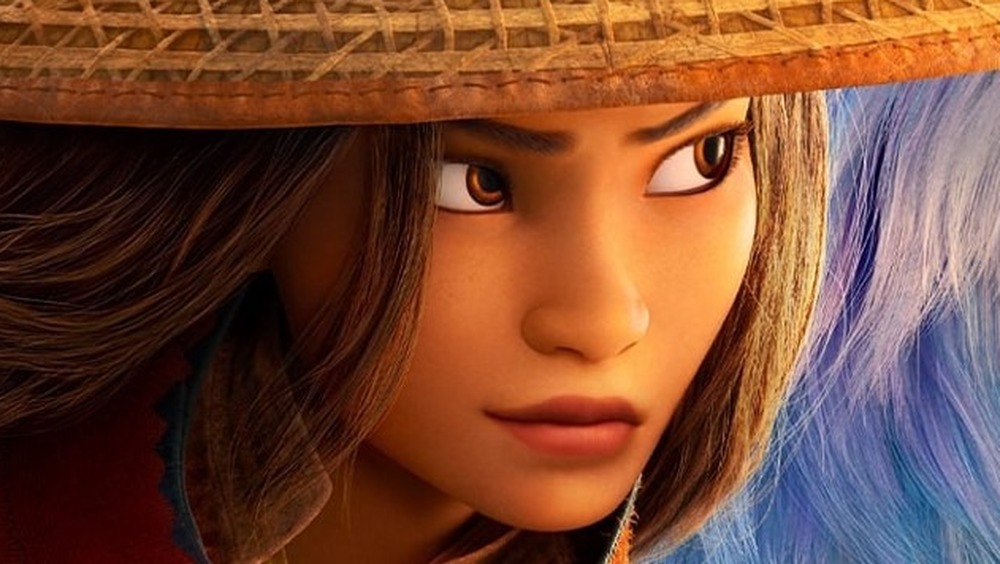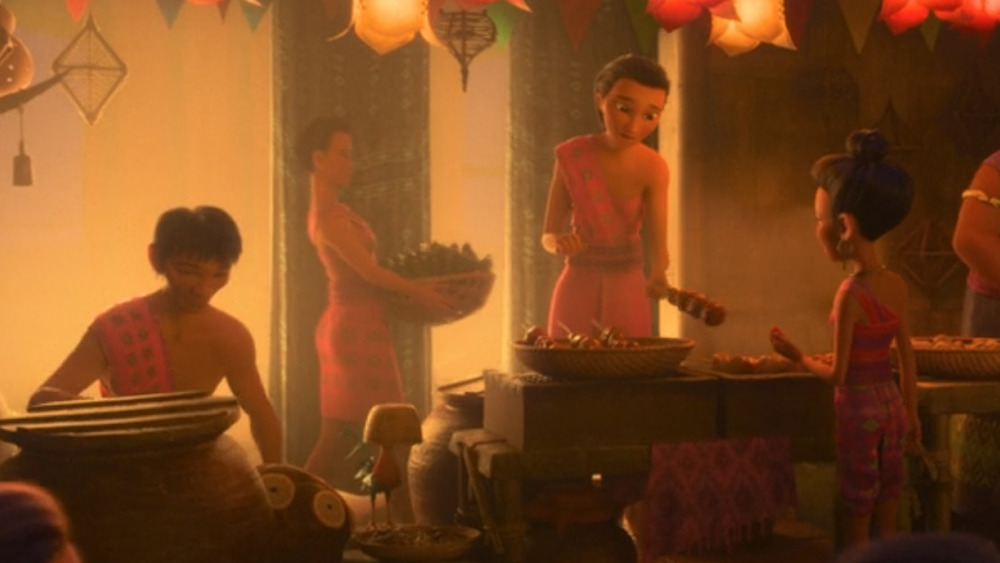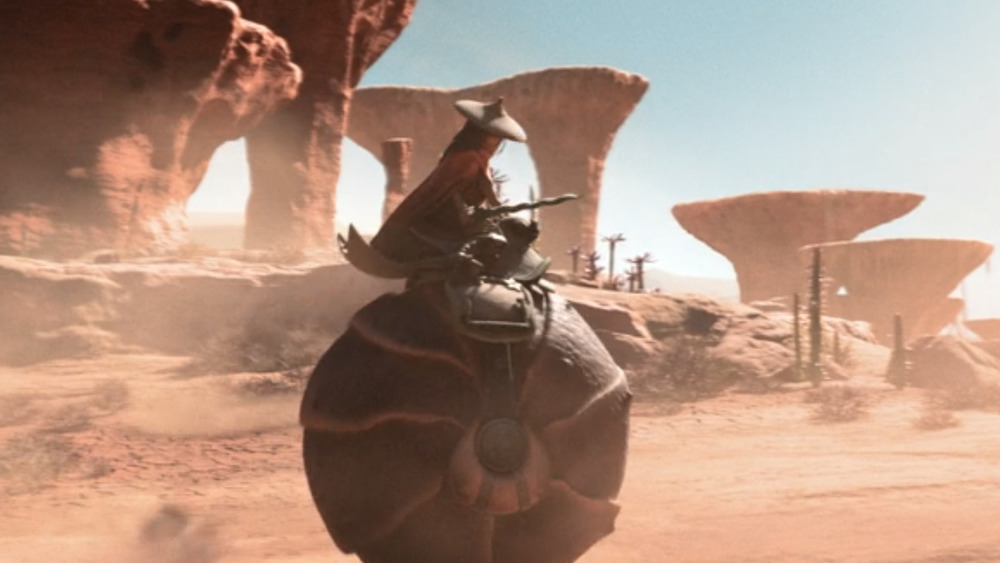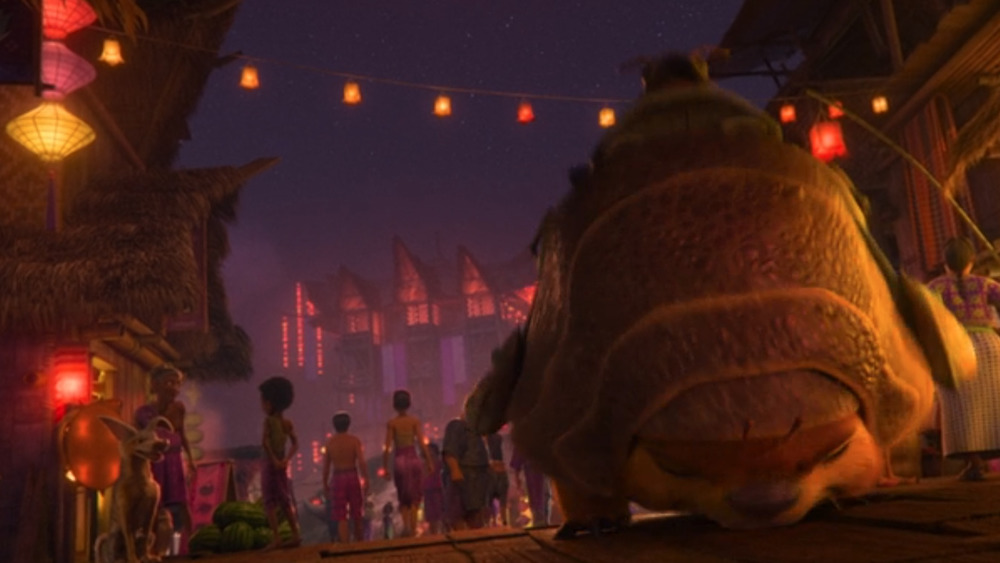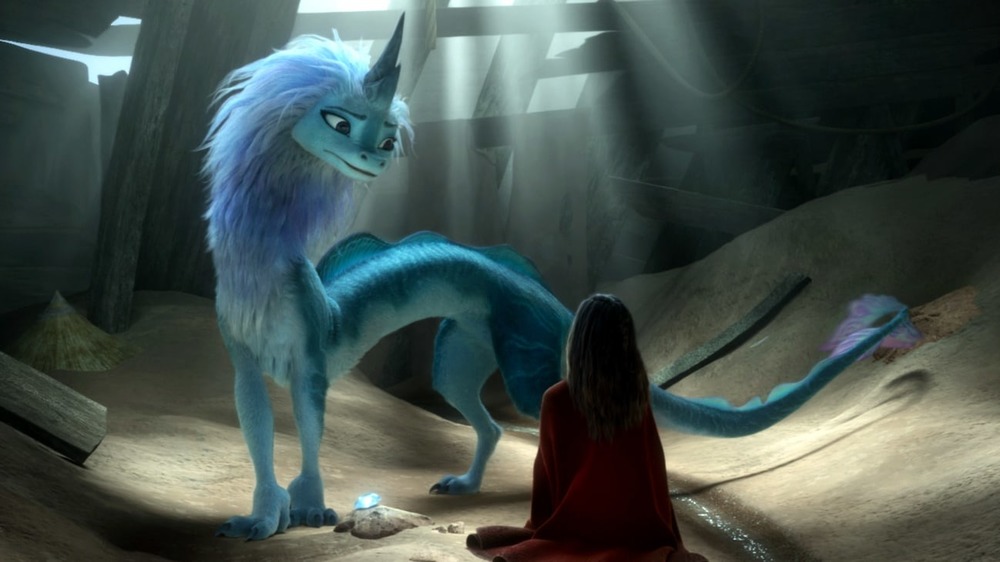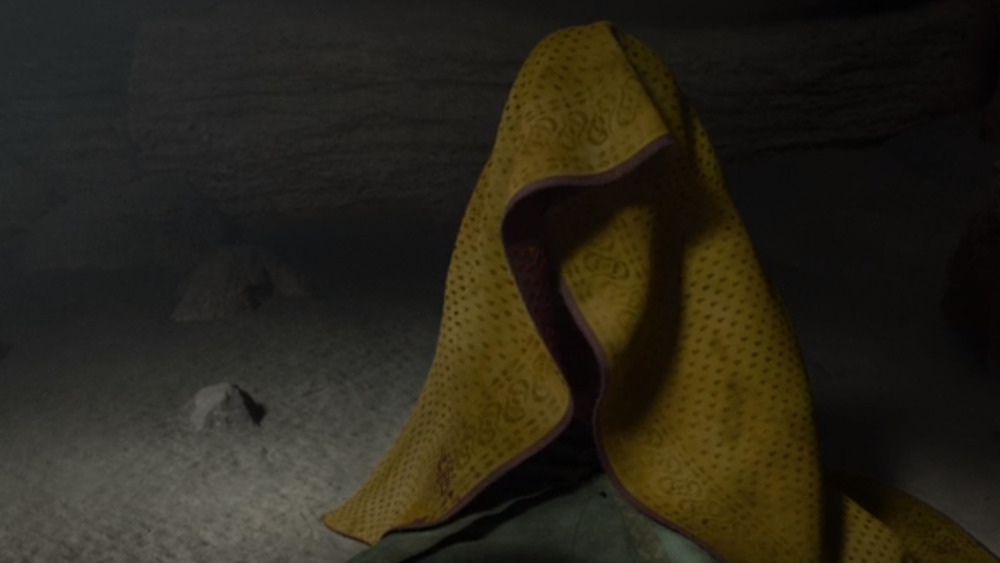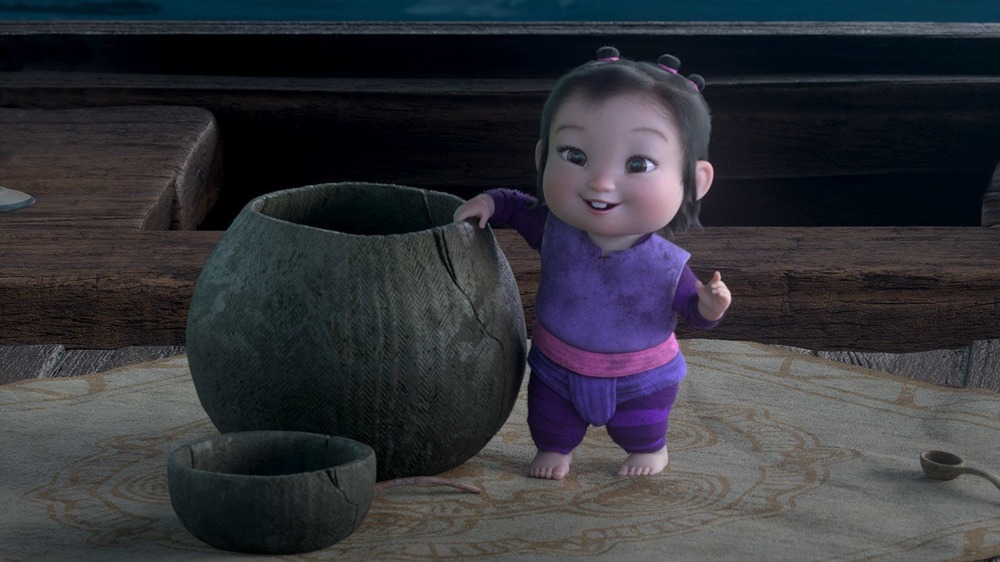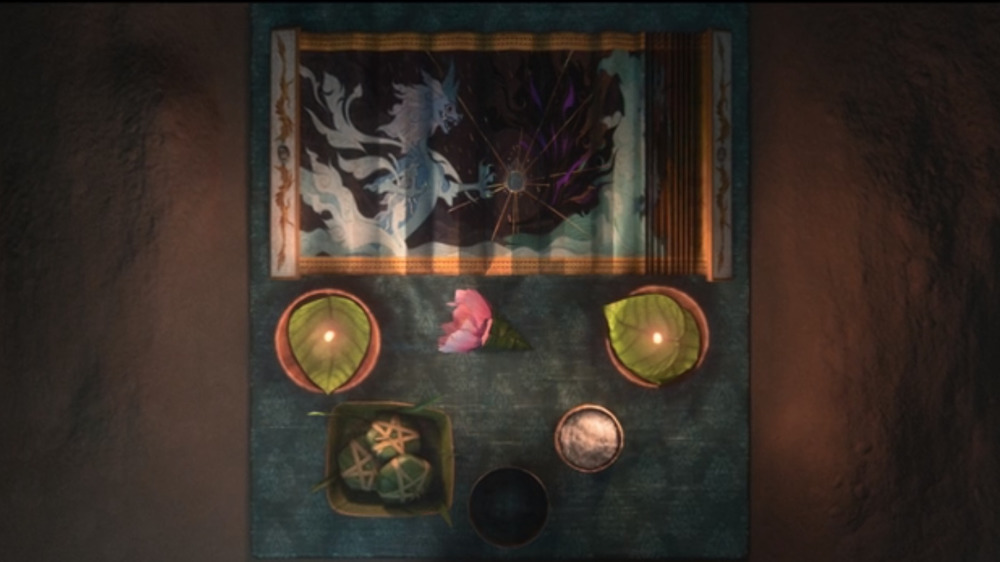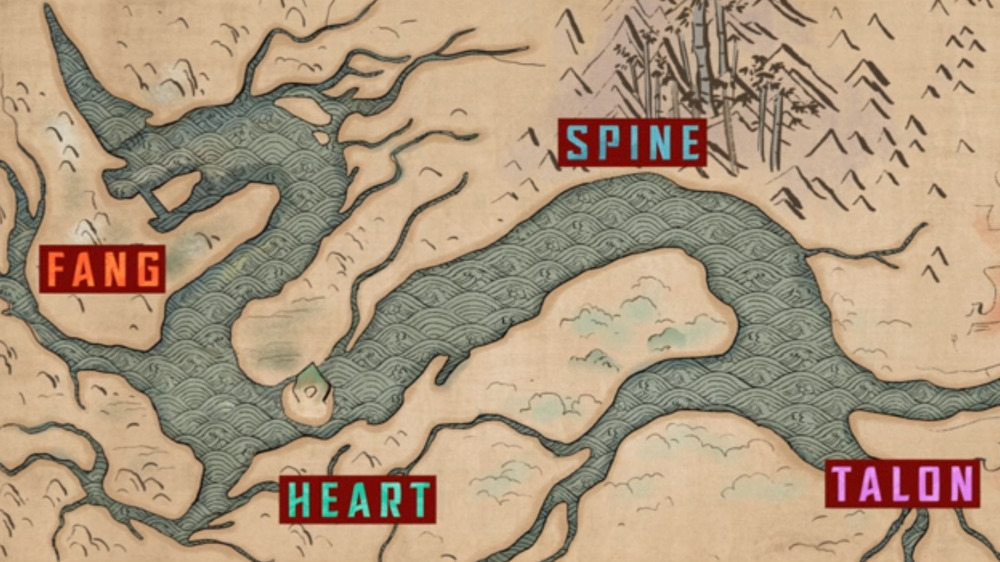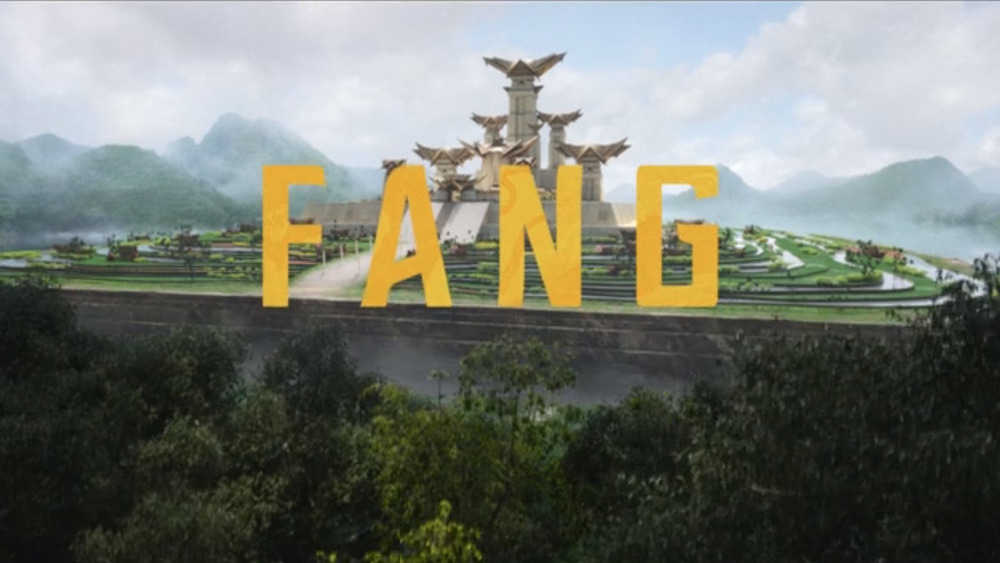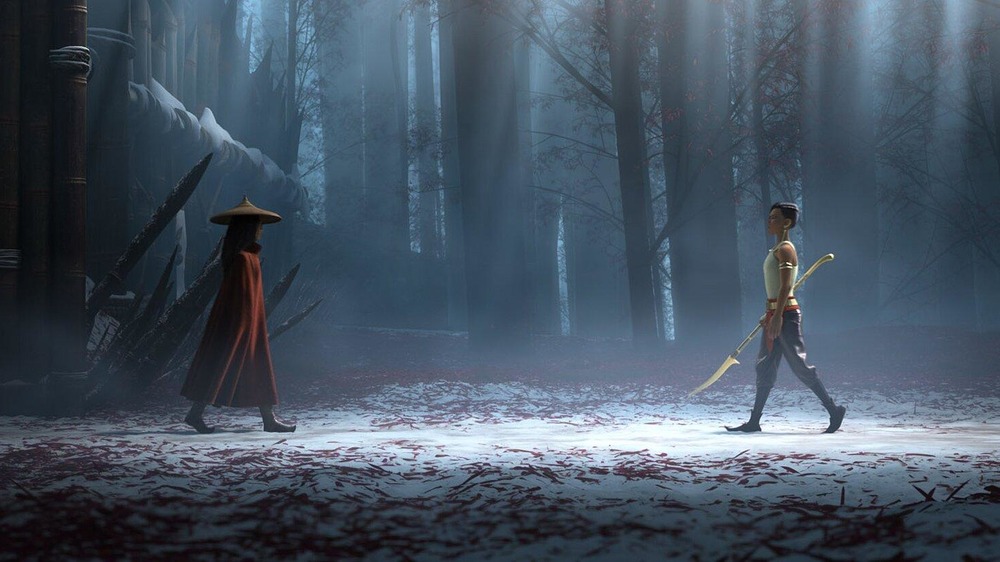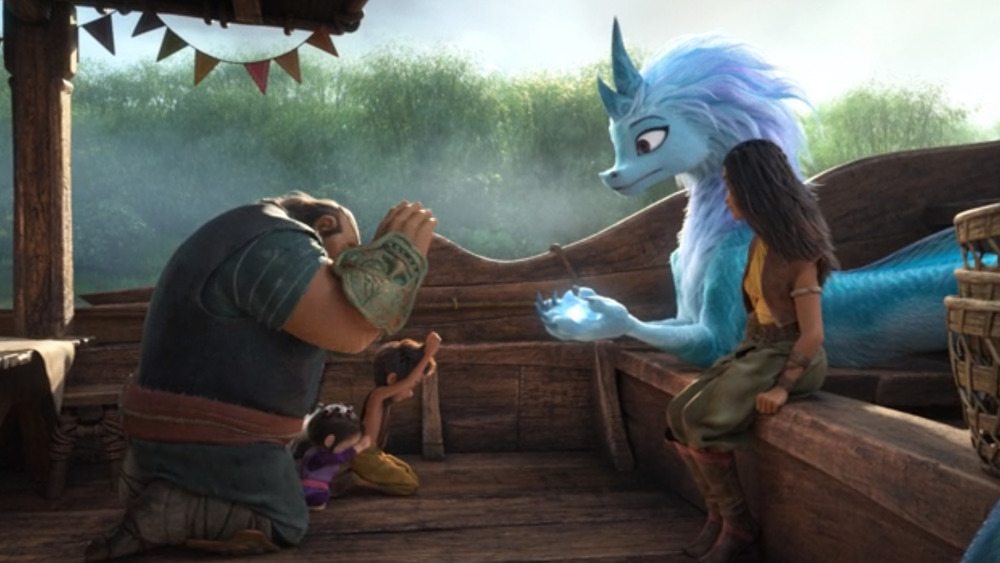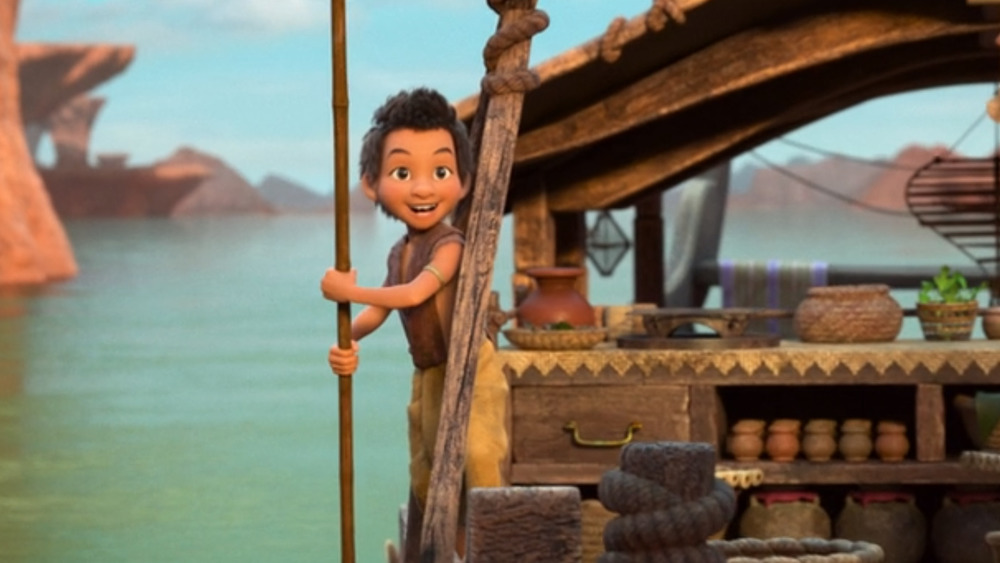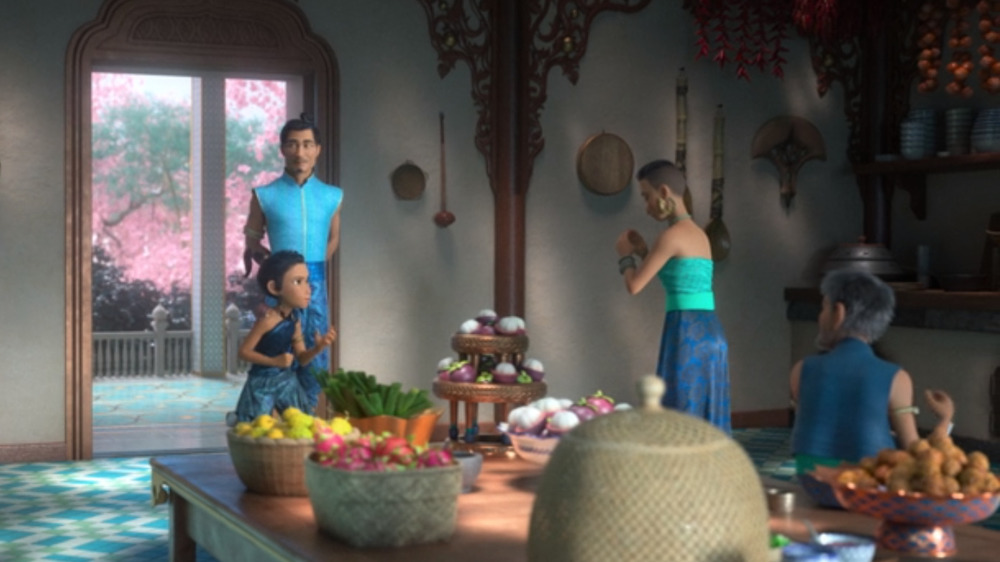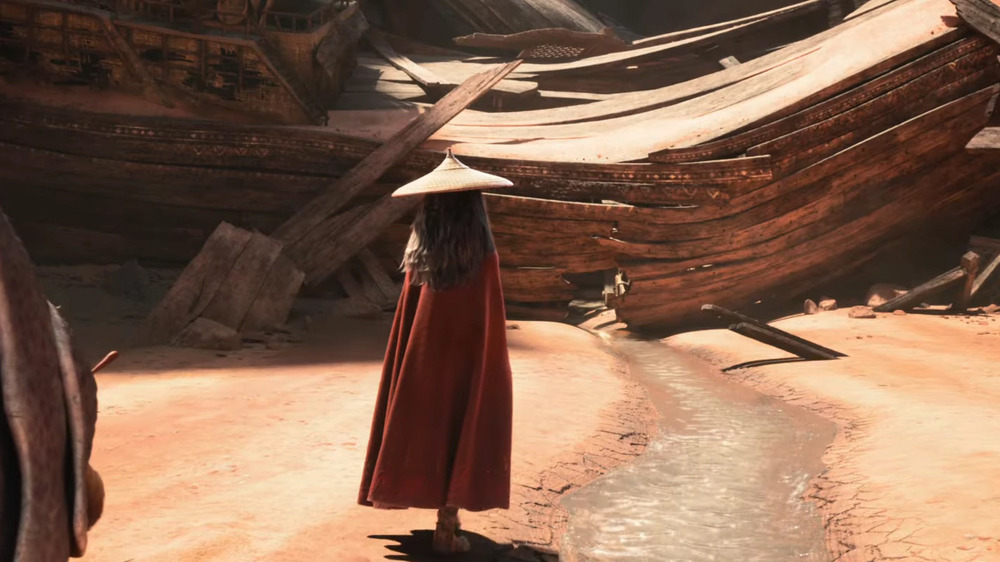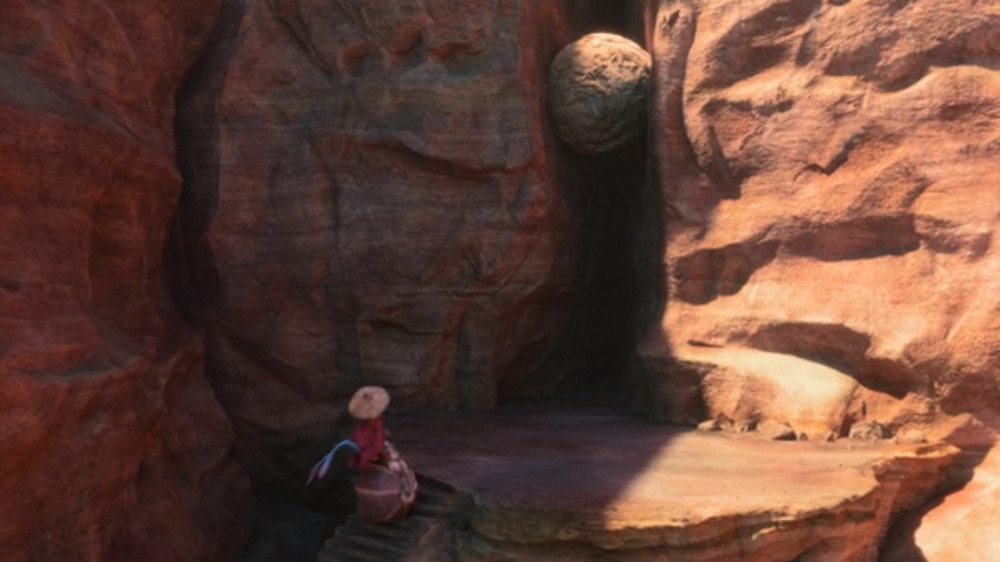Easter Eggs You Missed In Raya And The Last Dragon
Whenever you watch a Disney movie, you can be sure there will be an Easter egg or 10 hidden within it. It's no surprise, then, that Raya and the Last Dragon continues this proud tradition.
Raya and the Last Dragon takes place in the separated lands of the fictional realm of Kumandra: Heart, Tail, Spine, Talon, and Fang. Raya, our young heroine, is searching for Sisu, the last dragon of Kumandra, in order to unite the disparate nations. Human discord tore them apart, and feeds the amorphous evil known as the Druun, a rolling black wave that turns every person and animal into stone. A star-studded cast brings this tale to life, including Kelly Marie Tran as Raya, Awkafina as the dragon Sisu, Daniel Dae Kim as Chief Benja, Gemma Chan as Namaari, and a whole host of others.
The filmmakers took pains to assemble a Southeast Asia Story Trust, which helped make sure the film reflects the real-life cultures and history of Laos, Indonesia, Thailand, Vietnam, Cambodia, Singapore, and Malaysia. As a result, the film is full of vibrant details you might have missed. To help you take notice of each and every one, we've assembled this guide to Raya and the Last Dragon's many Easter eggs, from its hidden Mickeys to its references to Muay Thai.
Heihei the rooster takes a trip to Kumandra
Although Pua the pig is a whole lot cuter, as far as animal sidekicks go, Heihei the rooster is the creature who accompanies Moana on her adventure to restore the heart of Te Fiti in 2016's Moana. Indeed, the not-so-bright bird winds up traveling with her across the sea after accidentally stowing away on her boat. He might be dim-witted, but he still manages to get into all sorts of shenanigans — and he avoids getting eaten as well, despite Maui's interest in doing so.
Alan Tudyk, the actor who provided Heihei's voice, also voices Raya's pet and steed, Tuk Tuk. Possibly as a nod to Tudyk's stature — he's been called Disney's good luck charm – Heihei shows up very briefly in Talon's busy central marketplace. The appearance is perfectly in line with his character, as Heihei's head is covered with a basket. He's clearly getting into some sort of nuttery — which hopefully doesn't include ending up as a delicious skewer of meat.
Catching a ride on Tuk Tuk
Tuk Tuk, who appears to be part armadillo, part pill bug, and part pug, is Raya's constant and adorable companion. He's also her steed: We most frequently see him rolling underneath Raya like a living unicycle. This isn't just a neat idea, though — it's a cultural reference.
Tuk-tuks are a type of vehicle commonly seen in many Southeast Asian countries, also called an auto rickshaw. They are open-air, have three wheels, and get their name from the sound they make. Tuk-tuks originated in Japan in the 1930s, and went on to become popular throughout Southeast Asia. Raya's Tuk Tuk might not be motorized, but he does make a slightly automotive noise as he rolls along the roads of Kumandra. We feel comfortable saying he's a much cuter mode of transportation than his namesake vehicle, though some extremely pretty auto rickshaws give him a run for his money.
In contrast, Namaari, Raya's nemesis and the princess of Fang, rides a fictional cat called a serlot. This beast is opposite in temperament to Tuk Tuk, as Namaari seems to be to Raya. Cats hold a respected place in Southeast Asian culture, meaning Namaari's serlot is as much of an Easter egg as Tuk Tuk. Just another thing that makes her more like Raya than either of them realize.
Talon's marketplace contains a very important dog
As Raya walks through Talon's busy streets searching for Dang Hai, a number of shots reveal a dog that looks somewhat like a Xoloitzcuintli (also called Xolos), the type of dog portrayed in Disney's Coco. In fact, this pooch might just be a reference to Miguel's beloved pet, Dante. Though the dog seen in Talon's marketplace has floppy ears like Dante, he doesn't have the same goofy expression. More importantly, this dog doesn't appear to be hairless.
He could very well still be an Easter egg, however, in reference to Southeast Asian culture. In keeping with the meticulous design of the film, the Talon dog is most likely to be a Southeast Asian village dog. Village dogs, which are found throughout Asia, are not quite domesticated, and they are not purebreds. They are genetically diverse, and thought to be descendants of the original domesticated dogs of Central Asia from 15,000 years ago. In contrast, Xolos are only about 3,000 years old and, of course, originated in Mexico, where Coco is set. The dog in Talon might be there to remind the viewer of Dante — maybe he's one of Dante's great-great-great-great ancestors, who hopped a boat at some point? He might also be a reference to the long-standing presence of village dogs. Or hey, maybe he's both! Only one thing is certain: He's a good boy.
The dragons have deep mythical roots
In an interview with The Hollywood Reporter, Lao visual anthropologist Steve Arounsack, who headed the Southeast Asia Story Trust, discussed several of Raya's cultural details, including what inspired Sisu's design: the legendary Naga.
In Hinduism, Buddhism, and Jainism, Naga (which is Sanskrit for "serpent") are, according to Encyclopedia Britannica, "a member of a class of mythical semidivine beings, half human and half cobra." They have the ability to shapeshift — which Sisu identifies as Pranee's power — and can be good or bad, though they're usually good. They also live near and in bodies of water. One big difference between the Naga and Raya's dragons, though, is that Naga have no legs. Design-wise, this would've made it very hard to depict Sisu holding the magical Dragon Gem, so the design of the dragons was tweaked.
Depictions of Naga appear throughout the lands of Kumandra. This reflects real life: Naga have been carved into doors, adorned canopy beds, and guarded gates in the form of enormous statues. Basically, they're revered both in the film and in actual Southeast Asian culture.
Not every dragon reference is in the shape of a dragon
Raya's sword, which belonged to her father and which she uses after he is turned to stone, has a dragon and gem for a hilt. The necklace Namaari is wearing when she first meets Raya has the same dragon shape, including the gem in the middle. This repeated motif is a depiction of Sisu, the one being who binds the lands of Kumandra together, even as they drift apart. Additionally, the dragons who were turned to stone 500 years before the story begins dot the landscape: When passing through a valley full of the dormant creatures, Namaari and her entourage make sure to show them respect.
But literal depictions of dragons aren't the only way Sisu and her magical siblings are referenced in Raya and the Last Dragon – water symbols are everywhere in the film. One example is the raindrop motif on Raya's cape. As it turns out, Sisu's brother Pengu has the power to make rain, which isn't revealed until late in the film. The dragons' powers over water are a huge part of their magic — there is no life without water, of course, and rain is a big part of that relationship. Raya also has dragon symbols on her pants, but those are a bit more obvious. The raindrops are more of a "blink and you'll miss it" detail, paying homage to a dragon capable of bringing life-giving water to all of Kumandra.
What's in a name? Everything and more
Every name in Raya has meaning, but few viewers will grasp most of it. Consider Sisu's sister, the shape-shifting Pranee. Pranee means "living being, one that breathes" in Thai. Raya's name is also significant: It means "celebration" in Malay.
Two of the film's more interesting names are those of Sisu the dragon and Noi the con baby. Sisu, short for Sisudatu, doesn't seem to be a one-to-one translation from a particular language. However, in Finnish, Sisu means "strength of will." Throughout the film, we see that Sisu feels weak compared to her brothers and sisters. Despite this, when the Druun attack, Sisu's older brother Pengu chooses her to wield the magical Dragon Gem. Sisu's inner strength enables her to carry out her siblings' wishes, despite her insecurities.
Noi has a name with obvious meaning, as "noi" means "little" or "small" in Thai. If we examine her name in the context of other languages, we find even more meaning: For example, "noi" means "we" in Italian. That certainly fits the theme of the film: The five lands need to start trusting each other to fight the Druun and bring back their countrymen who've been turned to stone. It's not an "I, Raya" thing, or even a "Raya and Sisu" thing — it's about all of Kumandra working together as a big "we"to save the world.
Even the food has meaning
One of the notable visual elements of Raya is the food: It's colorful, occasionally abundant, and delectable-looking — save maybe for Raya's homemade jackfruit jerky. From Tuk Tuk eyeing the moo sarong (pork balls wrapped in noodles) to Boun's congee to the bánh tét Raya offers up when she tries to bring Sisu back early in the film, food plays an important part in the story.
When Chief Benja lays out a welcoming repast including tom yum for the delegations from other lands he invites to visit Heart, he's not just showing politeness — he's proving his desire for respect and unity. The feast also illustrates the fact that Heart has more resources than the other lands, which has bred envy: Namaari mentions that she hasn't had rice in quite some time shortly before she betrays Raya. Similarly, the appearance of the mango with sticky rice dish in the credits isn't just a picture of a tasty dessert: This staple of the Songkran Festival, which celebrates the Thai New Year, signifies "prosperity [and] fertile land." Given the barrenness of the landscapes we see and Namaari's jealousy of Heart's abundance, this dish symbolizes the broken nature of Kumandra ... and in time, its newfound strength in unity. Plus, it looks really yummy.
Kumandra and the mighty Mekong River
After the Dragon Gem is shattered, the freshly-empowered Druun attack Kumandra with terrifying strength. It takes Raya six long and arduous years, armed with a potent shard of the Dragon Gem, to search through all of Kumandra's rivers and eventually find Sisu. Raya grasps the exhaustive nature of her search as well as the audience does: She comments on how many tributaries the main river of Kumandra has when looking at a map of her world.
Given that the main inspiration for that key body of water is the real-world Mekong River, it's no wonder it took her so much time: The Mekong is about 2,700 miles long! This mighty river flows through and between the Southeast Asian countries of Laos, Thailand, Myanmar, Cambodia, and Vietnam. The Mekong is also associated with the legendary Naga, particularly the mysterious phenomenon known as the Naga fireballs. A Mekong-inspired river truly is the perfect setting for Raya's search for Sisu.
Each land combines cultures, yet has its own distinct style
Much of the architecture of Kumandra resembles Cambodia's iconic Angkor Wat temple complex, especially in Fang. Inspiration taken from the Indonesian rumah gadang style of house is also evident. Though the term "Southeast Asia" encompasses several countries, there are only five in Kumandra, and so the filmmakers drew inspiration from more than one when developing each land's distinct look.
Consider the gorgeous, chaotic, totally-filled-with-thieves floating market of Talon. This unique environment draws inspiration from two distinct Southeast Asian settings: The Vietnamese water markets of the Mekong River, and the luminous night markets of Thailand and Laos.
Such blended cultural details are also apparent in the types of weapons each land prefers, the type of clothing everyone wears, and even people's jewelry. Raya, for example, wears something very reminiscent of the Filipino salakot. This combination of various Southeast Asian cultures allows for more of them to be showcased in the film, while firmly establishing the fictional style of each land.
Several Southeast Asian fighting styles are showcased
Throughout most of Raya and the Last Dragon, the audience sees Raya as the good princess and Namaari as the bad one — though of course, the film's climax reveals they have far more in common than they think. One thing that is very different, though, is their approach to fighting.
When we first meet Raya, she is trying to get into the temple in Heart that houses the Dragon Gem. In order to open a secret stone doorway, she pulls out two bamboo sticks and puts them in holes in the stone to turn and unlock it. Those sticks are used in the Filipino martial arts form Arnis, which is also known as Kali and Eskrima. Arnis is mainly defensive and involves fighting with bastons (the sticks), swords (which Raya also wields), and daggers. It is a combination of various fighting forms developed over thousands of years. Raya also uses Pencak silat, which combines the art of movement, self-defense, physicality, and spirituality. Furthermore, Chief Benja's sword, which Raya wields after her father is turned to stone, is an Indonesian kris (sometimes called keris), which has a wavy blade and is considered to be a spiritual object as well as a weapon.
In contrast, Namaari uses Muay Thai and Krabi krabong. Muay Thai is somewhat similar to boxing, while Krabi krabong uses weapons. Both fighting styles originated in Thailand.
Cultural norms such as gift-giving and respectful hand gestures are highlighted
As Raya, Sisu, and their friends travel across Kumandra, Sisu frequently suggests giving gifts as a way of getting their merry band into the good graces of the people they're visiting. The giving of gifts is tradition in all of Asia, but there are different customs in different countries. One of the funniest scenes in the film is when Sisu, in her human form, goes through Talon's water market trying to pick out gifts for Dang Hai, although she has no idea what he likes or what could possibly offend him. Thus, she grabs whatever looks appealing until she has a pile of items to choose from. She's a very polite dragon!
Another important cultural norm is the use of a hand gesture to greet others. This is given a twist in Kumandra, as the characters make a gem shape with their hands when meeting each other. As Lao anthropologist Steve Arounsack told The Hollywood Reporter, this is "a creative take on the common greetings you'll see in the entire [Southeast Asian] region, where you have clasped hands. It's called a nop in Lao and a wai in Thai, but it's the same theme of bringing your hands together." In Kumandra, the height of the gesture indicates the amount of respect given: Sisu recieves the highest greetings of all, even from Noi and her mischievous pack of Ongis.
Boun functions as a ferryman
After Raya and Sisu meet 12-year-old Boun, he winds up going with them on their quest for the remaining pieces of the Dragon Gem. This allows the party to travel aboard his boat — or as he calls it, his "Shrimporium." Boun ferries them from land to land along Kumandra's river, but he doesn't do it for free — Raya has to offer him some of her jade as payment. As they travel, things become increasingly perilous for the gang.
Ferrymen frequently function as symbols in literature and myth. Consider Charon, a figure from Greek mythology who ferries the dead across the River Styx to Hades — a dangerous journey on a good day. The dead need to give Charon one coin as fare for safe passage, much like Raya has to bribe Boun with jade. Likewise, at the climax of the film, all the characters except Namaari wind up turned to stone, a form of death that is undone once Namaari is able to put the Dragon Gem back together and defeat the Druun. The Gem is used as a form of payment — albeit, one that brings the dead back over the border to the land of the living.
Hidden Mickeys of Kumandra
Savvy Disney fans know that the studio loves hiding Mickeys all over the place. There are, in fact, multiple books and websites dedicated to finding every "hidden Mickey" possible. A hidden Mickey isn't an actual drawing of Mickey Mouse placed somewhere, as in a Where's Waldo? puzzle, however. It's a simple representation of Mickey's head — one larger circle with two smaller circles on it.
In a recent interview with Malaysian website Says, directors Don Hall and Carlos López Estrada stated that there are hidden Mickeys in the land of Talon, including "tiny little" ones. If we're correct about one of those "tiny little" ones, then the three-dotted patterns on Talon chief Dang Hu's hat certainly count.
Other possible hidden Mickeys can be seen to the right of the kitchen Raya and her father enter early in the film, and on the larger of Raya's leather arm bands.
Yes, as a matter of fact, Disney does recycle
It's not a huge secret that Disney sometimes recycles animation in its films: Examples can be easily found on the internet. But sometimes, a scene is less recycled than it is deliberately echoing another Disney property. In this case, the shipwreck scene in Raya and the Last Dragon echoes the one in Frozen II.
In Frozen II, Anna and Elsa find a shipwreck which turns out to be the ship on which their parents perished. In what might be a wry nod to that scene, when Raya and Tuk Tuk come to the end of their search for Sisu, they find a wrecked ship. Raya comments, "Six years of searching and we end up at a literal shipwreck." Is the film making fun of Anna and Elsa's sad discovery? Probably not. But pointing out such a similar scene, even though it has a different outcome, is no doubt a wink to the Easter egg-savvy Disney fan.
Multiple movie references
The Hollywood Reporter quoted director Don Hall as saying that some of Raya's "swagger" is pulled from Guardians of the Galaxy's Star-Lord. That's definitely not the only movie Raya references.
When Tong decides to throw in his lot with Raya and Sisu, he says, "I, too, wish to join this fellowship of Druun buttkickery." We're counting this as a shout-out to another fantasy epic, The Lord of the Rings: The Fellowship of the Ring. Raya even wears her childhood hair ring on a necklace, after all, just like Frodo does with the One Ring!
Furthermore, there are some serious echoes of Raiders of the Lost Ark in the scene involving Raya going after the Dragon Gem in the Heart temple, and the one in which she and Sisu go after the Gem shard in Tail. There are booby traps aplenty, tricky feats of weight distribution, and even a giant boulder Sisu and Raya are forced to avoid, Indiana Jones-style.
Finally, when we are first introduced to Spine, the land's huge, well, spines could be a reference to Mary Alice, a stegosaurus from The Good Dinosaur. Considering she was excised from the final film, that would be a deep cut indeed. It could also very well be a sly reference to another more famous dinosaur, especially given how large and tough the denizens of Spine are. That dinosaur? None other than the legendary King of the Monsters himself, Godzilla. Come on — don't you see the resemblance?
